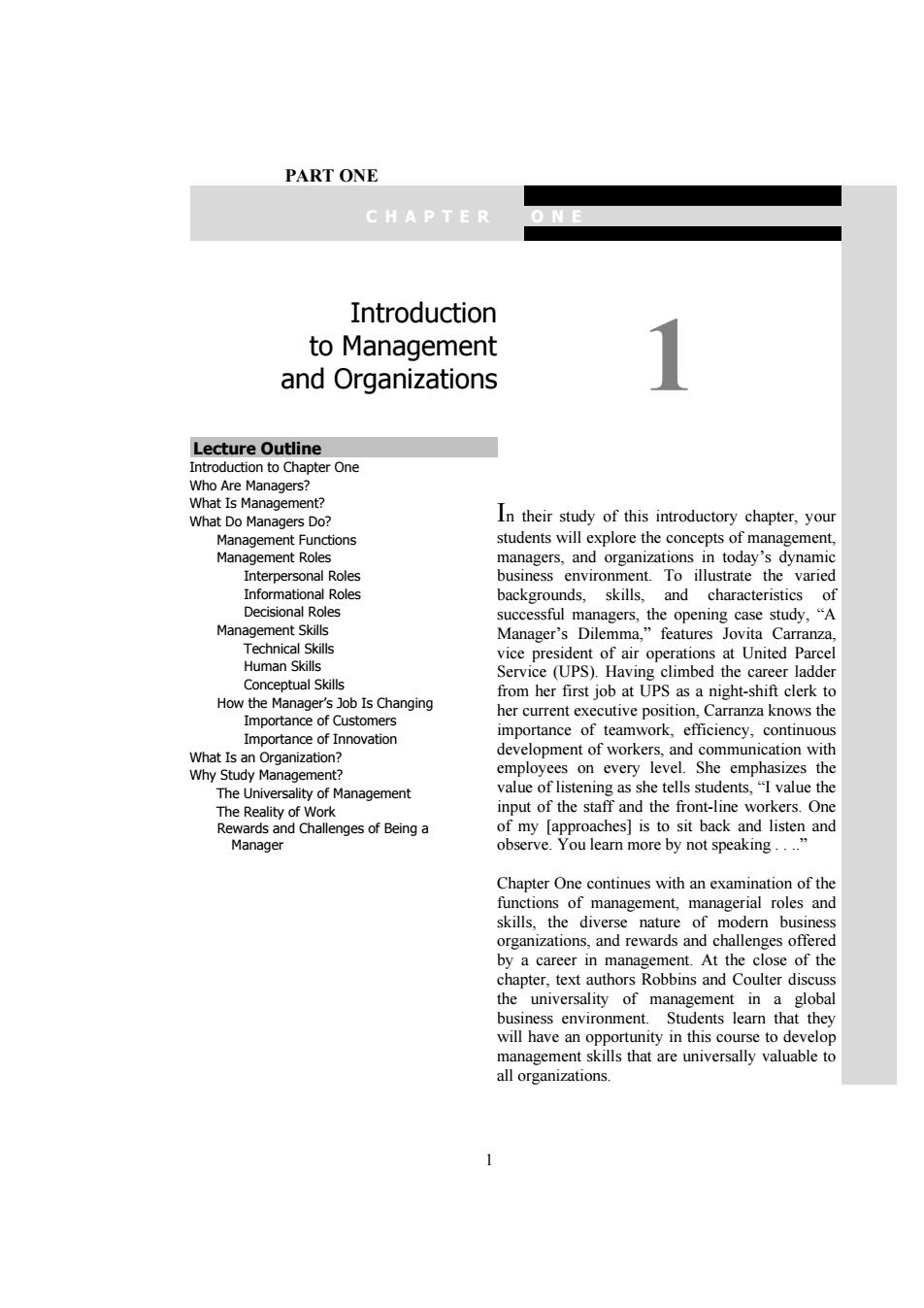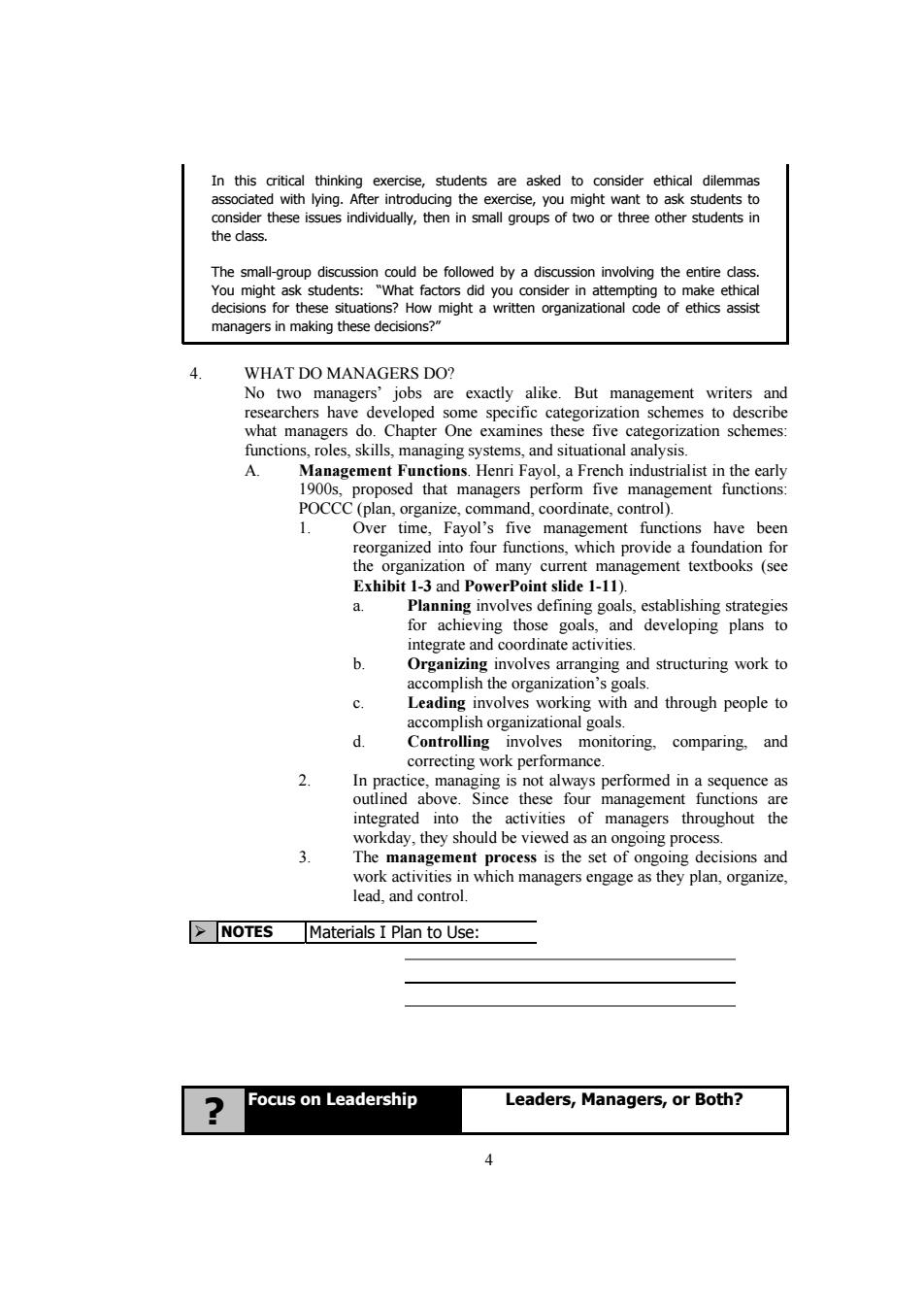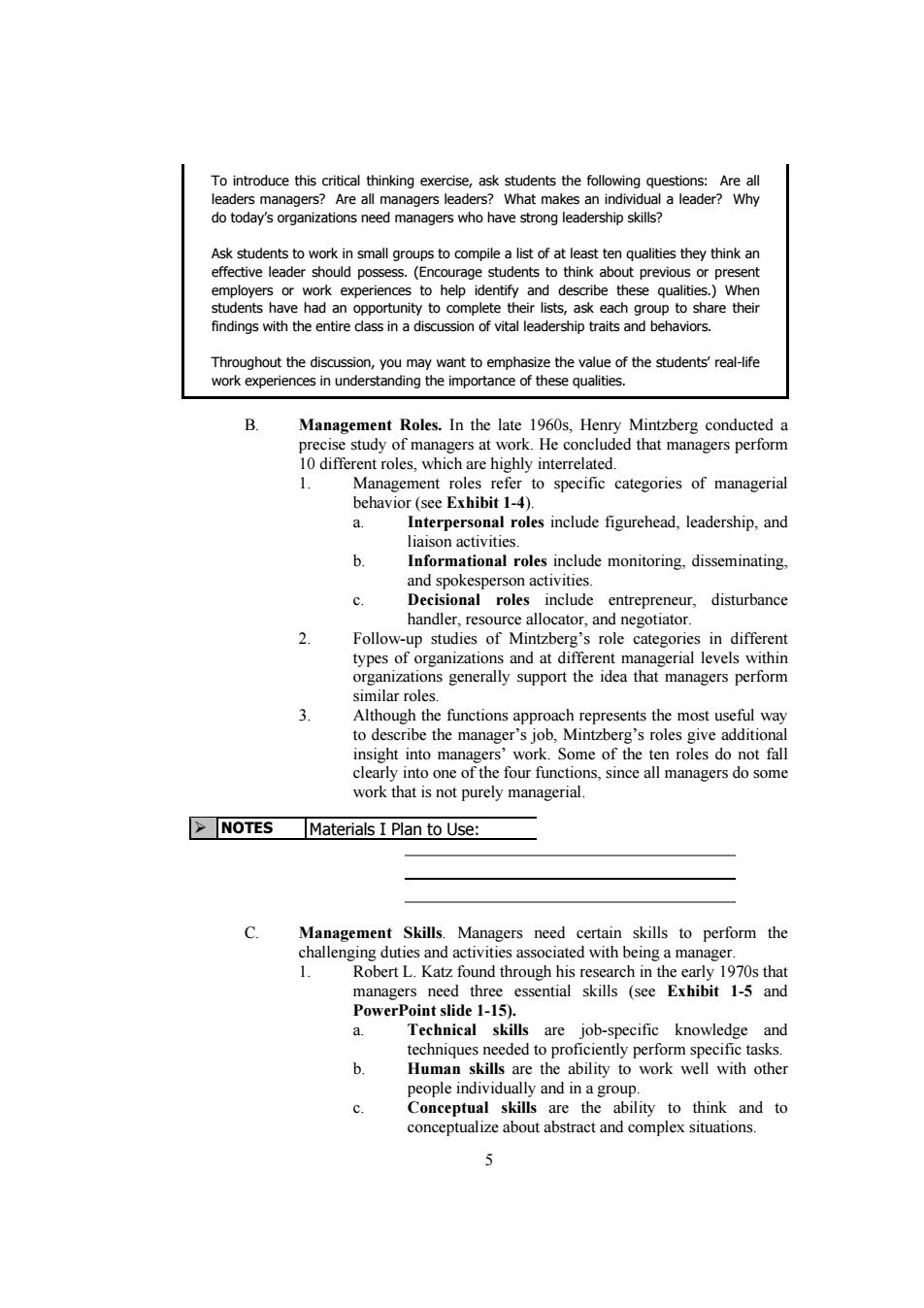
PART ONE CHAPTER Introduction to Management and Organizations Lecture Outline ntroduction to Chapter One ntheir study of this introductory chapter,you gers,and organi ions in today's dynami Interpersonal Role business environr ent.To illustrate the varie Management S Human Skil air op at United Pa first ioh at UPS ob Is Changin clerk Importance of Custor her current executive position,Carranza knows the wht1sanCganncdhnovatoi tear work, miciency,continuou Why Study Ma value of listening as she tells students,"I value the input of the staff and the Iron ers.On lenges of Being a -line ten and aonorh: kills the divers nature modern busi organizations,and rewards and uthors Robbins and Coulte dis the universality of management in a global ents learn tha ement skills that are sally valuable to all organizations
1 PART ONE CHAPTER ONE Introduction to Management and Organizations 1 Lecture Outline Introduction to Chapter One Who Are Managers? What Is Management? What Do Managers Do? Management Functions Management Roles Interpersonal Roles Informational Roles Decisional Roles Management Skills Technical Skills Human Skills Conceptual Skills How the Manager’s Job Is Changing Importance of Customers Importance of Innovation What Is an Organization? Why Study Management? The Universality of Management The Reality of Work Rewards and Challenges of Being a Manager In their study of this introductory chapter, your students will explore the concepts of management, managers, and organizations in today’s dynamic business environment. To illustrate the varied backgrounds, skills, and characteristics of successful managers, the opening case study, “A Manager’s Dilemma,” features Jovita Carranza, vice president of air operations at United Parcel Service (UPS). Having climbed the career ladder from her first job at UPS as a night-shift clerk to her current executive position, Carranza knows the importance of teamwork, efficiency, continuous development of workers, and communication with employees on every level. She emphasizes the value of listening as she tells students, “I value the input of the staff and the front-line workers. One of my [approaches] is to sit back and listen and observe. You learn more by not speaking . . .” Chapter One continues with an examination of the functions of management, managerial roles and skills, the diverse nature of modern business organizations, and rewards and challenges offered by a career in management. At the close of the chapter, text authors Robbins and Coulter discuss the universality of management in a global business environment. Students learn that they will have an opportunity in this course to develop management skills that are universally valuable to all organizations

hoth original text art and newly created to your students. ANNOTATED OUTLINE INTRODUCTION TO CHAPTER ONE Chanter One introduces the concepts of management,managers,and organizations through the xpraion of five majorun who are managers BC What do managers do? D. What is an organization,and how is the concept of an organization >NOTES☐Materials I Plan to Use:☐ 2. WHO ARE MANAGEKS of oon and work ofen i in formerly nonmanagerial jobs to perform managerial s employees ne >NOTES Materials I Plan to Use: B. How do we define a manager?A manager is someone who coordinat accomplished.However.keep in mind that managers may have additional work duties not related to coordinating the work of others NOTES Materials I Plan to Use: Q&A Why have orga this
2 A variety of PowerPoint slides, including both original text art and newly created images, are available for your use in enhancing the presentation of Chapter One materials to your students. ANNOTATED OUTLINE 1. INTRODUCTION TO CHAPTER ONE Chapter One introduces the concepts of management, managers, and organizations through the exploration of five major questions: A. Who are managers? B. What is management? C. What do managers do? D. What is an organization, and how is the concept of an organization changing? E. Why study management? ¾ NOTES Materials I Plan to Use: 2. WHO ARE MANAGERS? A. The changing nature of organizations and work often requires employees in formerly nonmanagerial jobs to perform managerial activities. Students who are preparing for careers on any organizational level can benefit from acquiring management skills. Today’s employees need to be cross-trained and multiskilled. ¾ NOTES Materials I Plan to Use: Q & A 1.1 If many traditional workers’ jobs now include managerial activities, why is the formal position of “manager” still needed in organizations? B. How do we define a manager? A manager is someone who coordinates and oversees the work of other people so that organizational goals can be accomplished. However, keep in mind that managers may have additional work duties not related to coordinating the work of others. ¾ NOTES Materials I Plan to Use: Q & A 1.2 Why have organizations traditionally been visualized as pyramids? Does this pyramidal form accurately reflect the new realities of organizational structure?

Mana eh时Pwr7 First Middle mans ers include all levels of management between the first-line level and the top level of the organization. 3 organization. >NOTES Materials I Plan to Use: WHAT IS MANAGEMENT? Management involves coordinating and overseeing the work activities r actvities are compl y and e least amount of puts PowerPoint slide 1-9). things righ Effectiveness is completing activities so that organizational en de d PowerPoint NOTES Materials I Plan to Use: fectverry fcient?Are effdent orgay Thinking Critically About Is Lying Ever Okay? Ethics
3 C. Managers can be classified by their level in the organization, particularly in traditionally structured organizations—those shaped like a pyramid (see Exhibit 1-1 and PowerPoint slide 1-7). 1. First-line managers (often called supervisors) are located on the lowest level of management. 2. Middle managers include all levels of management between the first-line level and the top level of the organization. 3. Top managers include managers at or near the top of the organization who are responsible for making organization-wide decisions and establishing plans and goals that affect the entire organization. ¾ NOTES Materials I Plan to Use: 3. WHAT IS MANAGEMENT? A. Management involves coordinating and overseeing the work activities of others so that their activities are completed efficiently and effectively. 1. Coordinating and overseeing the work of others is what distinguishes a managerial position from a nonmanagerial one. 2. Efficiency is getting the most output from the least amount of inputs in order to minimize resource costs. Efficiency is often referred to as “doing things right” (see Exhibit 1-2 and PowerPoint slide 1-9). 3. Effectiveness is completing activities so that organizational goals are attained and is often described as “doing the right things” (see Exhibit 1-2 and PowerPoint slide 1-9). ¾ NOTES Materials I Plan to Use: ? Thinking Critically About Ethics Is Lying Ever Okay? Q & A 1.3 Are effective organizations necessarily efficient? Are efficient organizations always effective?

In this critical thinking exercise,students are asked to consider ethical dilemmas the dass. ntire das might ask students: What factors did vo consider in attemptin to make ethica nagers of ethics assis WHAT DO MANAGERS DO exactly alike But ent writer s and es One examines the e five categorization schemes nent func rialist in the early 1900s proposed that managers perform five management functions: nagement textbooks (see establishin integrate and coordinate activities. b accomplish organizational goals. d Controlling monitoring,comparing.and outlined above.Since these four management oohatwetg e The manage ment pre ocess is the set of ongo ing decisions and nwhich manager theypan, ead,and contro NOTES Materials I Plan to Use: Focus on Leadership Leaders,Managers,or Both?
4 In this critical thinking exercise, students are asked to consider ethical dilemmas associated with lying. After introducing the exercise, you might want to ask students to consider these issues individually, then in small groups of two or three other students in the class. The small-group discussion could be followed by a discussion involving the entire class. You might ask students: “What factors did you consider in attempting to make ethical decisions for these situations? How might a written organizational code of ethics assist managers in making these decisions?” 4. WHAT DO MANAGERS DO? No two managers’ jobs are exactly alike. But management writers and researchers have developed some specific categorization schemes to describe what managers do. Chapter One examines these five categorization schemes: functions, roles, skills, managing systems, and situational analysis. A. Management Functions. Henri Fayol, a French industrialist in the early 1900s, proposed that managers perform five management functions: POCCC (plan, organize, command, coordinate, control). 1. Over time, Fayol’s five management functions have been reorganized into four functions, which provide a foundation for the organization of many current management textbooks (see Exhibit 1-3 and PowerPoint slide 1-11). a. Planning involves defining goals, establishing strategies for achieving those goals, and developing plans to integrate and coordinate activities. b. Organizing involves arranging and structuring work to accomplish the organization’s goals. c. Leading involves working with and through people to accomplish organizational goals. d. Controlling involves monitoring, comparing, and correcting work performance. 2. In practice, managing is not always performed in a sequence as outlined above. Since these four management functions are integrated into the activities of managers throughout the workday, they should be viewed as an ongoing process. 3. The management process is the set of ongoing decisions and work activities in which managers engage as they plan, organize, lead, and control. ¾ NOTES Materials I Plan to Use: ? Focus on Leadership Leaders, Managers, or Both?

leaders managers? Are all managers leader What makes an indivic do today's organiz Ask students towork in small groupsto compile a list of at least ten qulities they think ar employers or work exp riences to help identify and describe these qualities.)Whe to share the Management roles.in the late 1960s Henry mintzbe precise study of managers at work.He concluded that manager perfom c categories of managerial Interpersonal roles include figurehead,leadership,and and oesinclude monitoring disseminating. vitie c. Decisional roles include entrepreneur,disturbance handl 2. Follo reso and at dife organizations generally support the idea that managers perform insight into managers not purely >NOTES Materials I Plan to Use: Management Skills.Managers need certain skills to perform the challenging du ated with ing a manager rough PowerPoint slide 1-15). a Technical skills are ob. knowledge and 6 peopnidualyandgroup
5 To introduce this critical thinking exercise, ask students the following questions: Are all leaders managers? Are all managers leaders? What makes an individual a leader? Why do today’s organizations need managers who have strong leadership skills? Ask students to work in small groups to compile a list of at least ten qualities they think an effective leader should possess. (Encourage students to think about previous or present employers or work experiences to help identify and describe these qualities.) When students have had an opportunity to complete their lists, ask each group to share their findings with the entire class in a discussion of vital leadership traits and behaviors. Throughout the discussion, you may want to emphasize the value of the students’ real-life work experiences in understanding the importance of these qualities. B. Management Roles. In the late 1960s, Henry Mintzberg conducted a precise study of managers at work. He concluded that managers perform 10 different roles, which are highly interrelated. 1. Management roles refer to specific categories of managerial behavior (see Exhibit 1-4). a. Interpersonal roles include figurehead, leadership, and liaison activities. b. Informational roles include monitoring, disseminating, and spokesperson activities. c. Decisional roles include entrepreneur, disturbance handler, resource allocator, and negotiator. 2. Follow-up studies of Mintzberg’s role categories in different types of organizations and at different managerial levels within organizations generally support the idea that managers perform similar roles. 3. Although the functions approach represents the most useful way to describe the manager’s job, Mintzberg’s roles give additional insight into managers’ work. Some of the ten roles do not fall clearly into one of the four functions, since all managers do some work that is not purely managerial. ¾ NOTES Materials I Plan to Use: C. Management Skills. Managers need certain skills to perform the challenging duties and activities associated with being a manager. 1. Robert L. Katz found through his research in the early 1970s that managers need three essential skills (see Exhibit 1-5 and PowerPoint slide 1-15). a. Technical skills are job-specific knowledge and techniques needed to proficiently perform specific tasks. b. Human skills are the ability to work well with other people individually and in a group. c. Conceptual skills are the ability to think and to conceptualize about abstract and complex situations